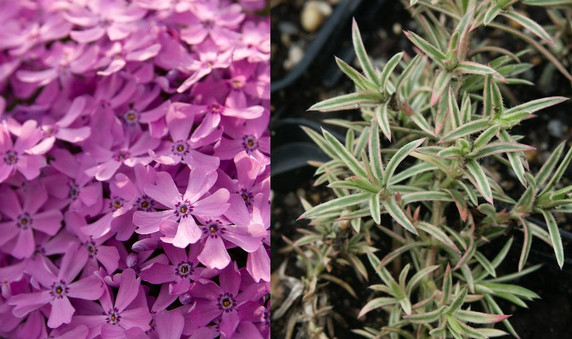Phlox subulata 'Nettleton's Variation' - MOSS PHLOX 'NETTLETON'S VARIATION' (variegated)
Cultivar of moss phlox with white variegation on leaf edges.
The variegation is the most visible in the spring (fades some in summer heat). But the whole plant still looks silver-gray even during the summer.
Pink flowers, medium sized mats.
Blooming time : usually for a couple weeks in April/May
Size : 3-4” tall x 18” wide
USDA zones : 3 to 9
Culture : full sun, half shade, dappled sun, organic, gravelly, rocky, sandy soils, poor and shallow soils, xeriscape. Adaptable plant, but drainage is essential!
Moisture Needs : dry, medium-dry, soil has to be drained
Origin : discovered in the late 1980s by Robert Potterton (British nurseryman) as a sport on Phlox subulata 'Alexander's Surprise'. Wild form of Phlox subulata is native wildflower to states from Michigan, Ontario and New York south to Tennessee and mainly in the Appalachians to North Carolina. Often found on dry, rocky or sandy places, open woodland areas, limestone barrens and slopes. See the USDA distribution map.
Deer/rabbit resistant : yes / yes
Attracts Butterflies or Pollinators : many insect are not active during it's flowering season, but can attract butterflies and various bees
Attracts Hummingbirds : no
Pot Size : square 3.5" perennial x 4" deep perennial pot (1.22 pt/580 ml)
Picture copyright :
Plant combinations : For the edges, along patios and paths, rock gardens, trough gardens, crevice gardens, slopes. Best combined with smaller to medium sized perennial – from native choose shorter Agastache, Anemone patens, Antennaria, Asclepias tuberosa, dwarf Baptisia, Campanula rotundifolia, Coreopsis, Cunila origanoides, Dalea, shorter Echinacea, Gaillardia, Gaura (shorter cultivars), smaller cultivars of Heuchera (in cooler regions), Penstemons, Ruellia humilis, shorter cultivars of Stokesia, Verbena canadensis, native grasses like Boutelloa gracilis, Koeleria cristata, Sporobolus heterolepis 'Tara' (or non-native Sesleria).
And non-native perennials like Achillea, summer blooming Allium, shorter Aquilegia, Armeria, Calamintha, Campanula, Cerastium, Delosperma, Dianthus, Geranium (G. sanquineum, G. dalmaticum and x cantabrigiense, G. cinereum, G. endresii, G. renardii), Gypsohila, Iris (dwarf and miniature bearded Iris), shorter Lavandula, shorter Nepeta, Origanum, shorter Platycodon, Satureja, Salvia, Sedum, Sempervivum, low Stachys,Scabiosa columbaria, Thymus, lower Veronica and many spring bulbs.

Phlox subulata 'Nettleton's Variation' - MOSS PHLOX 'NETTLETON'S VARIATION' (variegated)
Cultivar of moss phlox with white variegation on leaf edges.
The variegation is the most visible in the spring (fades some in summer heat). But the whole plant still looks silver-gray even during the summer.
Pink flowers, medium sized mats.
Blooming time : usually for a couple weeks in April/May
Size : 3-4” tall x 18” wide
USDA zones : 3 to 9
Culture : full sun, half shade, dappled sun, organic, gravelly, rocky, sandy soils, poor and shallow soils, xeriscape. Adaptable plant, but drainage is essential!
Moisture Needs : dry, medium-dry, soil has to be drained
Origin : discovered in the late 1980s by Robert Potterton (British nurseryman) as a sport on Phlox subulata 'Alexander's Surprise'. Wild form of Phlox subulata is native wildflower to states from Michigan, Ontario and New York south to Tennessee and mainly in the Appalachians to North Carolina. Often found on dry, rocky or sandy places, open woodland areas, limestone barrens and slopes. See the USDA distribution map.
Deer/rabbit resistant : yes / yes
Attracts Butterflies or Pollinators : many insect are not active during it's flowering season, but can attract butterflies and various bees
Attracts Hummingbirds : no
Pot Size : square 3.5" perennial x 4" deep perennial pot (1.22 pt/580 ml)
Picture copyright :
Plant combinations : For the edges, along patios and paths, rock gardens, trough gardens, crevice gardens, slopes. Best combined with smaller to medium sized perennial – from native choose shorter Agastache, Anemone patens, Antennaria, Asclepias tuberosa, dwarf Baptisia, Campanula rotundifolia, Coreopsis, Cunila origanoides, Dalea, shorter Echinacea, Gaillardia, Gaura (shorter cultivars), smaller cultivars of Heuchera (in cooler regions), Penstemons, Ruellia humilis, shorter cultivars of Stokesia, Verbena canadensis, native grasses like Boutelloa gracilis, Koeleria cristata, Sporobolus heterolepis 'Tara' (or non-native Sesleria).
And non-native perennials like Achillea, summer blooming Allium, shorter Aquilegia, Armeria, Calamintha, Campanula, Cerastium, Delosperma, Dianthus, Geranium (G. sanquineum, G. dalmaticum and x cantabrigiense, G. cinereum, G. endresii, G. renardii), Gypsohila, Iris (dwarf and miniature bearded Iris), shorter Lavandula, shorter Nepeta, Origanum, shorter Platycodon, Satureja, Salvia, Sedum, Sempervivum, low Stachys,Scabiosa columbaria, Thymus, lower Veronica and many spring bulbs.


